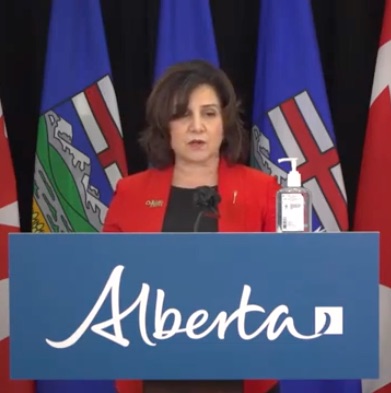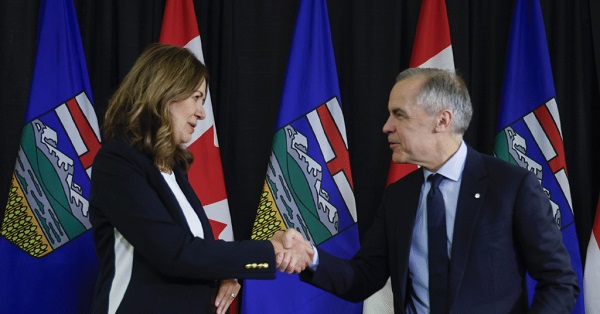Alberta
Making money matter to Alberta students

Alberta’s government is getting students the training they need to better understand saving, budgeting, spending and investing.
To make sure junior and senior high students have the financial knowledge for today’s world, Alberta’s government is releasing a call for grant proposals totaling $1 million. The successful organization, or group of organizations, will work with schools to provide financial literacy programming to students starting in fall 2021.
Students will study financial concepts such as costs, interest, debt, investing, insurance and how the economy affects their lives. This call for grant proposals will expand learning opportunities to students in classrooms across the province.
“For the first time in a meaningful way, financial literacy is being addressed across multiple subjects and grades in an age-appropriate way in our province. Understanding how money works will help students gain confidence, solve practical problems and prepare them for the future.”
“Strong financial management is the foundation of a successful economy. Likewise, it’s an essential life skill that can add immense value to one’s personal endeavours. This is why I’m proud of the $1 million investment in financial literacy education, which will support our youth transitioning into adulthood and better equip them for personal and professional success.”
“Integrating financial literacy concepts across multiple grades will help to ensure we don’t just prepare students for a successful career, but for a successful life. Teaching financial literacy will empower countless Alberta students with the foundational tools needed not only to manage their finances, but to build their own business. These are essential skills for our changing economy.”
“It’s never too early to become financially literate. The ability to understand finances, in terms of budgets, income, expenses, saving, borrowing, credit – this is knowledge, skills and practices that will not only last one’s entire life, but enable young Albertans to set themselves up for success and to lead a prosperous life. Students are Alberta’s future entrepreneurs – future business owners, restauranteurs, innovators, creators – all roles that require sound knowledge and insight into finances and budgets. I applaud the Government of Alberta for investing in the financial literacy of Alberta’s next generation.”
This call for grant proposals builds on successful current financial literacy programs, including those offered by Enriched Academy and Junior Achievement in the 2020/21 school year. These organizations have been working with 39,000 students in Grades 4 to 12 in the past year – in urban and rural communities.
“Normally, the seriousness involved in personal financial literacy can be overlooked when you’re 15 or 16. But through this training, my students and I have been able to have meaningful, quality conversations about investing, credit, debt and so much more.”
“Before joining Junior Achievement, all I knew was that companies pay their employees, and people have to budget their own money. However, after joining, I learned that there are so many more steps and so much effort goes into this. I’ve also learned all about making decisions that financially benefit a business or individual – break-even points, budgeting, investing, financial management and so many more financial skills. This program has made a change in my life for the better.”
By focusing on financial literacy, Alberta’s government aligns with the Ministerial Order on Student Learning released last fall. Developed following consultations with parents, teachers and education experts, it calls for students to acquire competence in managing personal finances.
Financial literacy was also among recommendations from Alberta’s independent curriculum advisory panel. In their report, the panel noted students may leave Grade 12 without the basic skills necessary to transition successfully into life after high school. They recommended financial literacy, work readiness, wellness and goal-setting to enhance student learning.
As part of the work to refocus on essential knowledge in Alberta’s elementary schools, financial literacy is also a key component of Alberta’s draft kindergarten to grade 6 curriculum, under the theme of practical skills. In the draft, all students will study financial literacy in all subjects and grades – from counting coins to creating a budget.
Quick facts
- Details on the call for grant proposals will be available in May through the Alberta Purchasing Connection.
Alberta
Ottawa-Alberta agreement may produce oligopoly in the oilsands

From the Fraser Institute
By Jason Clemens and Elmira Aliakbari
The federal and Alberta governments recently jointly released the details of a memorandum of understanding (MOU), which lays the groundwork for potentially significant energy infrastructure including an oil pipeline from Alberta to the west coast that would provide access to Asia and other international markets. While an improvement on the status quo, the MOU’s ambiguity risks creating an oligopoly.
An oligopoly is basically a monopoly but with multiple firms instead of a single firm. It’s a market with limited competition where a few firms dominate the entire market, and it’s something economists and policymakers worry about because it results in higher prices, less innovation, lower investment and/or less quality. Indeed, the federal government has an entire agency charged with worrying about limits to competition.
There are a number of aspects of the MOU where it’s not sufficiently clear what Ottawa and Alberta are agreeing to, so it’s easy to envision a situation where a few large firms come to dominate the oilsands.
Consider the clear connection in the MOU between the development and progress of Pathways, which is a large-scale carbon capture project, and the development of a bitumen pipeline to the west coast. The MOU explicitly links increased production of both oil and gas (“while simultaneously reaching carbon neutrality”) with projects such as Pathways. Currently, Pathways involves five of Canada’s largest oilsands producers: Canadian Natural, Cenovus, ConocoPhillips Canada, Imperial and Suncor.
What’s not clear is whether only these firms, or perhaps companies linked with Pathways in the future, will have access to the new pipeline. Similarly, only the firms with access to the new west coast pipeline would have access to the new proposed deep-water port, allowing access to Asian markets and likely higher prices for exports. Ottawa went so far as to open the door to “appropriate adjustment(s)” to the oil tanker ban (C-48), which prevents oil tankers from docking at Canadian ports on the west coast.
One of the many challenges with an oligopoly is that it prevents new entrants and entrepreneurs from challenging the existing firms with new technologies, new approaches and new techniques. This entrepreneurial process, rooted in innovation, is at the core of our economic growth and progress over time. The MOU, though not designed to do this, could prevent such startups from challenging the existing big players because they could face a litany of restrictive anti-development regulations introduced during the Trudeau era that have not been reformed or changed since the new Carney government took office.
And this is not to criticize or blame the companies involved in Pathways. They’re acting in the interests of their customers, staff, investors and local communities by finding a way to expand their production and sales. The fault lies with governments that were not sufficiently clear in the MOU on issues such as access to the new pipeline.
And it’s also worth noting that all of this is predicated on an assumption that Alberta can achieve the many conditions included in the MOU, some of which are fairly difficult. Indeed, the nature of the MOU’s conditions has already led some to suggest that it’s window dressing for the federal government to avoid outright denying a west coast pipeline and instead shift the blame for failure to the Smith government.
Assuming Alberta can clear the MOU’s various hurdles and achieve the development of a west coast pipeline, it will certainly benefit the province and the country more broadly to diversify the export markets for one of our most important export products. However, the agreement is far from ideal and could impose much larger-than-needed costs on the economy if it leads to an oligopoly. At the very least we should be aware of these risks as we progress.

Elmira Aliakbari
Alberta
A Christmas wish list for health-care reform

From the Fraser Institute
By Nadeem Esmail and Mackenzie Moir
It’s an exciting time in Canadian health-care policy. But even the slew of new reforms in Alberta only go part of the way to using all the policy tools employed by high performing universal health-care systems.
For 2026, for the sake of Canadian patients, let’s hope Alberta stays the path on changes to how hospitals are paid and allowing some private purchases of health care, and that other provinces start to catch up.
While Alberta’s new reforms were welcome news this year, it’s clear Canada’s health-care system continued to struggle. Canadians were reminded by our annual comparison of health care systems that they pay for one of the developed world’s most expensive universal health-care systems, yet have some of the fewest physicians and hospital beds, while waiting in some of the longest queues.
And speaking of queues, wait times across Canada for non-emergency care reached the second-highest level ever measured at 28.6 weeks from general practitioner referral to actual treatment. That’s more than triple the wait of the early 1990s despite decades of government promises and spending commitments. Other work found that at least 23,746 patients died while waiting for care, and nearly 1.3 million Canadians left our overcrowded emergency rooms without being treated.
At least one province has shown a genuine willingness to do something about these problems.
The Smith government in Alberta announced early in the year that it would move towards paying hospitals per-patient treated as opposed to a fixed annual budget, a policy approach that Quebec has been working on for years. Albertans will also soon be able purchase, at least in a limited way, some diagnostic and surgical services for themselves, which is again already possible in Quebec. Alberta has also gone a step further by allowing physicians to work in both public and private settings.
While controversial in Canada, these approaches simply mirror what is being done in all of the developed world’s top-performing universal health-care systems. Australia, the Netherlands, Germany and Switzerland all pay their hospitals per patient treated, and allow patients the opportunity to purchase care privately if they wish. They all also have better and faster universally accessible health care than Canada’s provinces provide, while spending a little more (Switzerland) or less (Australia, Germany, the Netherlands) than we do.
While these reforms are clearly a step in the right direction, there’s more to be done.
Even if we include Alberta’s reforms, these countries still do some very important things differently.
Critically, all of these countries expect patients to pay a small amount for their universally accessible services. The reasoning is straightforward: we all spend our own money more carefully than we spend someone else’s, and patients will make more informed decisions about when and where it’s best to access the health-care system when they have to pay a little out of pocket.
The evidence around this policy is clear—with appropriate safeguards to protect the very ill and exemptions for lower-income and other vulnerable populations, the demand for outpatient healthcare services falls, reducing delays and freeing up resources for others.
Charging patients even small amounts for care would of course violate the Canada Health Act, but it would also emulate the approach of 100 per cent of the developed world’s top-performing health-care systems. In this case, violating outdated federal policy means better universal health care for Canadians.
These top-performing countries also see the private sector and innovative entrepreneurs as partners in delivering universal health care. A relationship that is far different from the limited individual contracts some provinces have with private clinics and surgical centres to provide care in Canada. In these other countries, even full-service hospitals are operated by private providers. Importantly, partnering with innovative private providers, even hospitals, to deliver universal health care does not violate the Canada Health Act.
So, while Alberta has made strides this past year moving towards the well-established higher performance policy approach followed elsewhere, the Smith government remains at least a couple steps short of truly adopting a more Australian or European approach for health care. And other provinces have yet to even get to where Alberta will soon be.
Let’s hope in 2026 that Alberta keeps moving towards a truly world class universal health-care experience for patients, and that the other provinces catch up.
-

 Energy2 days ago
Energy2 days agoThe Top News Stories That Shaped Canadian Energy in 2025 and Will Continue to Shape Canadian Energy in 2026
-

 Business2 days ago
Business2 days agoSome Of The Wackiest Things Featured In Rand Paul’s New Report Alleging $1,639,135,969,608 In Gov’t Waste
-

 International2 days ago
International2 days ago$2.6 million raised for man who wrestled shotgun from Bondi Beach terrorist
-

 Frontier Centre for Public Policy15 hours ago
Frontier Centre for Public Policy15 hours agoTent Cities Were Rare Five Years Ago. Now They’re Everywhere
-

 Alberta2 days ago
Alberta2 days agoOttawa-Alberta agreement may produce oligopoly in the oilsands
-

 Energy2 days ago
Energy2 days ago‘The electric story is over’
-

 Opinion15 hours ago
Opinion15 hours agoPope Leo XIV’s Christmas night homily
-

 Energy2 days ago
Energy2 days agoWestern Canada’s supply chain for Santa Claus





